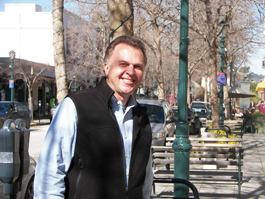home | metro santa cruz index | news | santa cruz | news article

Photograph by Steve Hahn
Smiling Through His Tears: Regional Transportation Commission chief George Dondero keeps looking on the bright side of the local transportation funding situation.
Back to Square One
Last week, a long-sought transportation tax for the Santa Cruz area was strangled in its crib. Now what?
By Steve Hahn
George Dondero sits back comfortably in his chair, smiling despite the bad news that just hit the Regional Transportation Commission (RTC), of which he serves as executive director. Recent developments notwithstanding, he knows all is not lost.
First the bad news: on Feb. 7, RTC commissioners decided to kill a sales tax measure into which Dondero and numerous others had poured over two years of work. Proponents had been hoping to put the measure, which would have implemented a half-cent sales tax increase over 35 years to pay for $600 million worth of transportation projects, on the November 2008 ballot. But after a deep ideological divide materialized between transportation activists, largely over whether to widen Highway 1, and fears over a sagging economy took hold, the commission killed the measure—at least for this election cycle.
Dondero maintains his composure. After all, there is good news: at the same meeting, the RTC nominated $5.47 million worth of transportation projects to be funded by the state over the next two years. That money, stashed away in the State Transportation Improvement Program (STIP) fund, will more than likely find its way to RTC coffers, although the nominations still need to be approved by the California Transportation Commission. Dondero has faith the money will come through, at least this time around.
"The $5.5 million will probably be all right, but the next STIP cycle in two years could be impacted by the $14 billion budget deficit they're dealing with in Sacramento," he says.
Once the money sails into Santa Cruz County, probably around June 2008, RTC staffers will begin chipping away at the $2 billion maintenance backlog they face. County roads scheduled for repair include Bean Creek, Freedom Boulevard, 38th Avenue, Carlton Road and Varni Road.
Additionally, some of the funds will go toward new projects, such as the long-awaited San Lorenzo River Bike Bridge in Santa Cruz and Highway 1 merge lanes connecting onramps with offramps between Soquel and Morrissey. Widening the highway will have to wait at least until the next election cycle in 2010, as will any money for starting passenger train service.
There's more than just fresh asphalt and construction delays to look forward to over the next two years. The godsend that is the Freeway Service Patrol will also be extended for the next five years. These angels of smooth travel cruise Highway 17 looking for car wrecks. Once they find them—and Lord knows they do—they hitch the wrecked car onto the towline and get the hunk of metal out of everyone's way. For free. These professional good Samaritans routinely prevent multicar pileups on the winding stretch of road.
These are all great projects, but to ease the county's congested traffic infrastructure and get that maintenance backlog cleared up, voters will eventually need to approve some locally generated funding. The sad but true fact is that state and federal funds will never cover all the county's transit needs. State funds get picked over by dozens of needy counties, and are often rerouted by the Legislature to fund schools and other state expenditures during bad budget years.
"The STIP used to be a lot more stable, now it's not. You can't count on it," notes Dondero. "The state has taken a bigger and bigger chunk of that money. Just the maintenance of the state highway system in the last 10 years has gone up from $1 billion a year to over $2 billion a year now. They get their cut off the top of that pot before the allocations get made to the regions."
There will be quite a bit of work ahead if the RTC hopes to make another run at putting a sales tax measure on the ballot in 2010. The two-year push to get agreement on this year's failed tax measure cost the RTC $560,000, and there was still opposition from environmentalists and the Santa Cruz chapter of the Republican Party. Then there was the abysmal failure of Measure J in 2004, which wasn't even able to attract majority approval, not to mention the two-thirds supermajority it actually needed to pass.
Some transit activists, however, are hoping to strike a fresh compromise. Paul Elerick of the Campaign for Sensible Transportation says he will continue advocating his 20-year half-cent sales tax measure, which would fund Highway 1 improvements (but not widening), plus passenger train service, road repairs and extended bus service.
It is unclear whether the RTC will try its luck with a tax measure for a third time. Chances are the commission will discuss this at its March 6 meeting, after much licking of wounds.
In any event, the RTC certainly faces a rocky road ahead, which makes Dondero's smiling face all the more mysterious. Maybe it's just the Santa Cruz vibe—after all, Dondero has no illusions about the challenges he faces.
"A lot of our projects are long-term," he says. "You need stable funding for these projects because they take a long time to get done. It's a real problem."
Send a letter to the editor about this story.
|
|
|
|
|
|